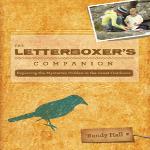There is a breed of modern day treasure hunter that utilizes the Internet, a knack for orienting and solving puzzles, and a sense of adventure to acquire its prize. But these 21st century explorers are not seeking riches, they're after something called a letterbox.
As a cold rain spits on a car ferry in western Ireland, James and Nancy Hartigan and their two children huddle together in the car, plotting the rest of the day's travel.
"Killimer to Knock around Kilmore to Lab, and then back to Kilkerrin," James says. "And then we will hit the Battery at Lackyle, back out, probably hit the cemetery, and then up the road."
Letterboxing journey
This is the final leg of their journey from Ashland, Virginia, to their father's ancestral home to see relatives and leave behind a letterbox.
"We have been doing this letterboxing thing for a while," James says. "And it is just a kind of neat way of connecting with people, you know, as opposed to sending emails and what-not. It is something that you have to travel to go get."
A letterbox is a weather-proof box which typically contains a hand-carved rubber stamp and notebook. A letterboxer hides it in a public place, and posts clues and directions for finding it on the Internet. Those who find a box, use the stamp to mark their personal notebook and leave an imprint of their own stamp in the letterbox's notebook. Then they put the box back in its hiding place for the next treasure hunter to find.
"I definitely like the whole letterbox thing," says Sean Hartigan, 10, who carved a train to use as his personal stamp. "I am actually kind of hoping for, like, next time we come, eight or nine notes in there."

Connecticut DEP Division of Forestry
A typical letterbox contains a stamp, stamp pad and record book, which are left at the letterbox site.His older sister Maggie has written an introductory passage in the notebook. "I wrote about my hat and about how awesome Ireland is, and I am going to move here when I get rich, along with many other things."
But, first, they have to hide the box, which involves a long drive through drizzling rain over bumpy back roads and an after-dark arrival at the final resting place for many of James Hartigan's ancestors.
"This is Kilkirren cemetery," says James, once they arrive at their destination. "The gravestones would be several hundred years old."
The family wedges its letterbox into a crack in the cemetery wall. They have given clues to its location to their relatives.
Unique pastime
Letterboxing began in bog-covered parkland in Devon, England, in 1854.
"A gentleman left his calling card out on the moors and said, 'Anyone to find this also do the same or write a little note,' that sort of thing," says Randy Hall, an American software engineer and author of "The Letterboxer's Companion."
Hikers started leaving their cards. The idea caught on and word of other hikers hiding boxes in remote areas with cryptic directions spread through word of mouth. Stamps eventually replaced cards. For more than a century, the pastime was limited to a few enthusiasts on the moors.

Globe Pequot Press
'The Letterboxer's Companion,' is author Randy Hall's guide to letterboxing, which is similar to old-fashioned scavenger hunts.A 1998 article in a major U.S. magazine introduced letterboxing to many Americans. Its popularity soared thanks to the Internet, which has become the primary means of distributing clues.
In Britain, Hall says, the clues often require the use of a compass, while in the United States, directions and puzzles dominate.
"It is kind of like setting up treasure hunts," he says. "It is like a mental activity, a brainy activity."
Hall is renowned for his clever and complex puzzles. The only clue he provides for locating a North Carolina letterbox is a haiku poem:
Roll's pal in a noose
Sign marks his lupine brother
Pine tree to the north.
"I like people to have an 'aha' experience when they figure it out. They feel, 'Wow, that is really cool.' To create a sense of discovery," Hall says. "I do not like it when it is just ‘Walk down the path and look under a rock.'"
Working together
Letterboxing is also catching on as a vacation activity. Andrea Wyman and her family make it part of every vacation, including a 2010 trip to Ohio.
"We were letterboxing on Lake Erie and we ended up in a forest area that we probably would not have gone to at all," she says. "But the letterbox was hidden within a little campground."
Wyman, an associate professor at Edinboro University of Pennsylvania, has designed a course on letterboxing for grandparents and their grandchildren.
She says the pastime encourages generations to work together while enjoying the outdoors and exploring new places. And, solving the puzzles and writing the clues are good workouts for the brain.

Courtesy of Andrea Wyman
Hannah Wyman's letterboxing notebook contains stamps from the letterboxes she's found near home and while on vacation."When you are trying to help someone find your letterbox, you are editing, reading and reviewing everything that you write down on your clue list so that you can help someone come and find your hidden book," Wyman says.
Her 11-year-old daughter, Hannah, has found her fair share of boxes. She says letterboxing allows her to do what she calls ‘cool stuff' that does not involve computers.
"We went to this park and then it said from this certain tree take 42 third-grader steps," Hannah says. "And I was a third-grader at that time, so I got to figure out where the letterbox was."
She stamped the book with her snowflake stamp and walked away with a souvenir and a fond memory. The treasure - for her, the Hartigans and the thousands of other letterboxers - is in the hunt.
